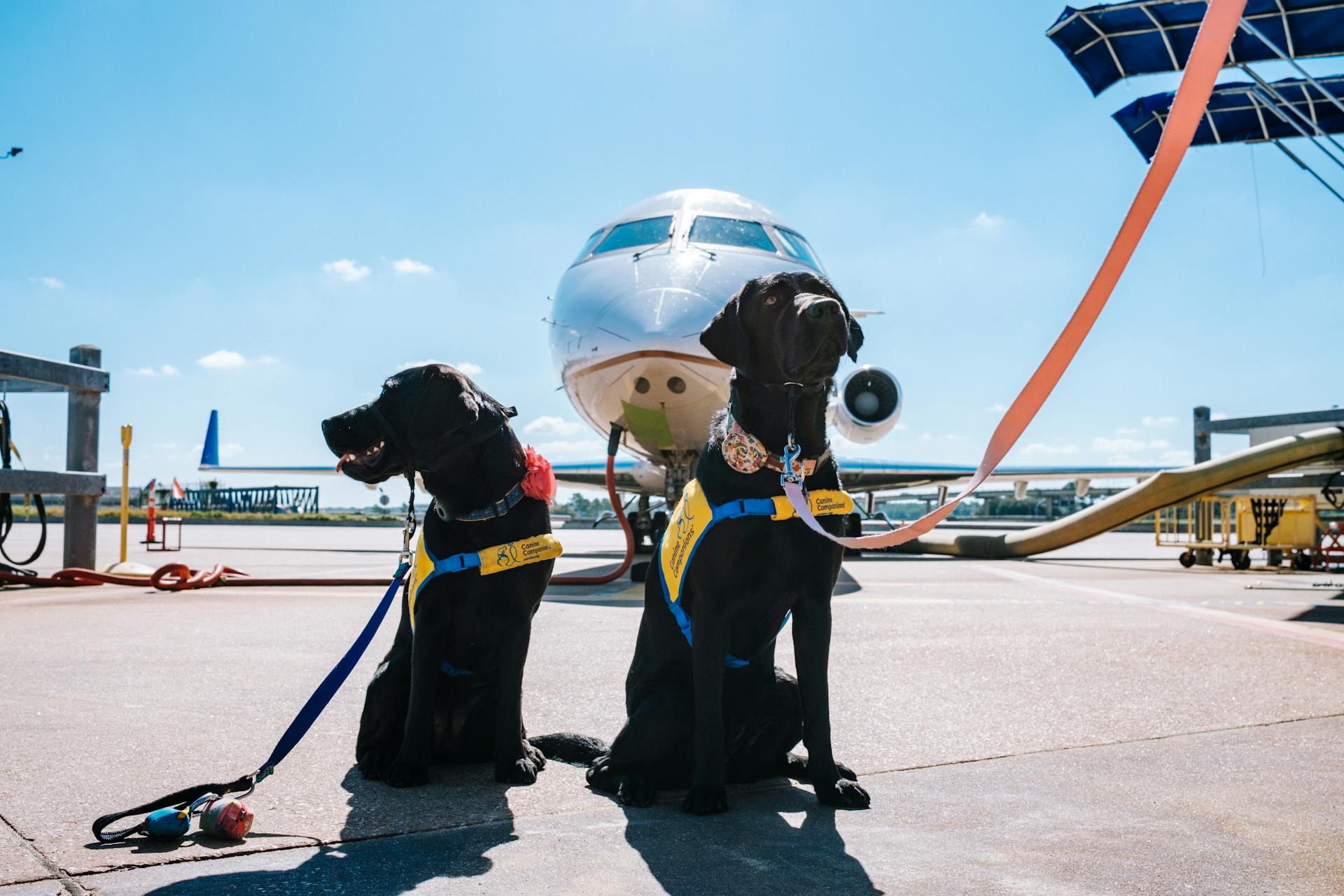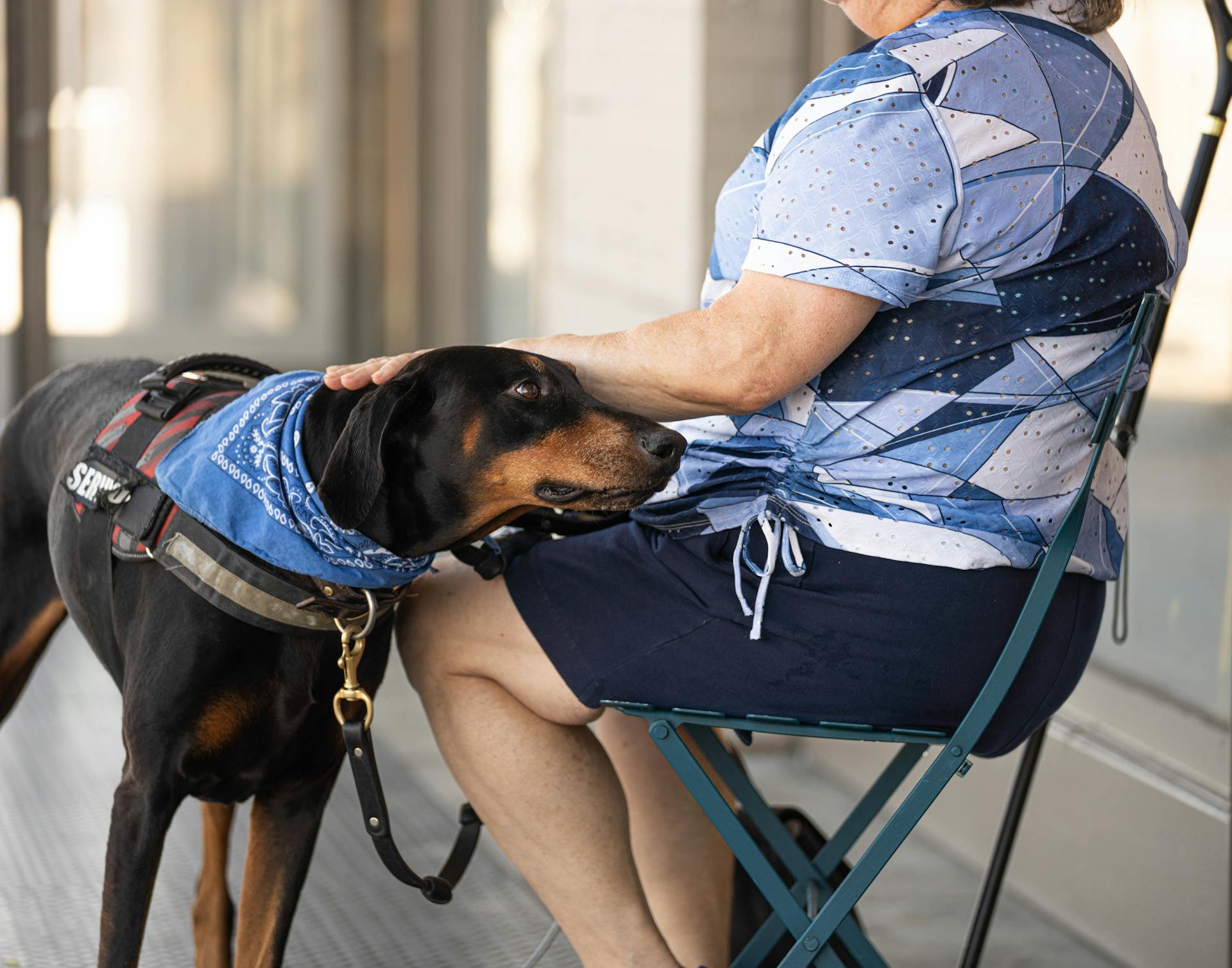
Flying with a service dog can be a wonderful experience, but it's essential to know the rules and regulations beforehand. Service dogs are allowed in the cabin with their owners, but they must be well-behaved and under control at all times.
In the United States, the Air Carrier Access Act requires airlines to accommodate service dogs and their owners. This means that service dogs are not considered pets and are exempt from pet fees.
Service dogs must be trained to behave well in public, including on planes. They should not be a distraction or a disruption to other passengers.
Airline Requirements
You don't need to provide proof or certification papers to take your service dog on a flight, but you'll need to fill out a Department of Transportation form annually that attests to your service dog's health, behavior, and training.
Airlines limit the number of service dogs to two per individual, and dogs under the age of 4 months are not allowed to fly as service animals.
Suggestion: Do Service Dogs Need to Be Registered
Service dogs also are not allowed to sit in the exit row of a plane.
For flights longer than eight hours, you must fill out a form stating your dog can either refrain from using the bathroom on the flight or provide a plan for how they will relieve themselves.
Here are some airline-specific requirements to keep in mind:
Airline-Specific Information
If you're planning to fly with your service dog, it's essential to know the airline-specific requirements. American Airlines, for example, has the same requirements as Delta, and once you've submitted your form, you'll receive an email with your Service Animal ID (SVAN ID) that you can use to book future travel.
Some airlines, like Southwest, require you to present the completed form at the ticket counter or gate on the day of travel, and you'll need to have a new form each time you fly. United Airlines, on the other hand, allows service dogs in training who are flying with their trainers to fly, but you'll need to complete the forms electronically for domestic flights.
Here's a quick rundown of some popular airlines' requirements:
Flying Air Canada
Flying Air Canada with a service dog can be a bit more complex than flying with them on other airlines. For flights to and from the U.S., Air Canada allows up to two service dogs, provided they both fit within the seat footprint of the passenger.
You'll need to fill out the DOT paperwork and send it to the Air Canada Medical Assistance desk at least 48 hours before departure. The airline requires this paperwork for flights to and from the U.S.
Service dogs in training are not allowed on flights to and from the U.S. with Air Canada, unlike some other airlines. However, they may be allowed on other flights with Air Canada.
If you're flying with a service dog on Air Canada, you'll need to be prepared to answer questions about your dog's training and abilities. The airline representative may ask you what task your dog is trained to perform and may ask to see the DOT form and a copy of the rabies vaccine.
Air Canada has a disability access line for TSA screenings at many airports, which can make the process of flying with a service dog much easier.
Broaden your view: Paperwork for Service Dogs
Requirements by Airline

American Airlines requires a Service Animal ID (SVAN ID) for service dogs, which can be obtained by submitting a form and having it approved by the airline. You'll need to add the SVAN ID when booking future travel with the same animal to avoid resubmitting the form.
Air Canada has different requirements for service dogs depending on the flight destination. For flights to and from the U.S., you can bring up to two service dogs, but for other flights, your service dog must have been individually trained by an organization or person specializing in service dog training.
Air Canada also requires you to fill out the DOT paperwork and send it to the Air Canada Medical Assistance desk at least 48 hours before departure for flights to and from the U.S.
All U.S. airlines have similar requirements for service dogs, but some specifics vary. For example, dogs under 4 months old are not allowed to fly as service animals, and many airlines do not recognize service dogs in training as service animals.
For another approach, see: Are Service Animals Only Dogs

Here's a breakdown of some popular airlines' service dog requirements:
Airlines are required to accommodate service animals, including providing a bulkhead seat if requested, and escorting individuals to animal relief areas in the terminal.
Flying Southwest Airlines
Flying Southwest Airlines requires you to fill out the DOT forms to fly with a service animal. You'll need to present the completed form at the ticket counter or gate on the day of travel.
Southwest mandates that the form be dated on or after the date you purchased your ticket, so you'll need a new form each time you fly. This is an important detail to keep in mind when planning your travel.
You can also let the airline know in advance that you'll be flying with your service dog by using the Special Assistance link when booking a ticket.
Related reading: Southwest Airlines Policy on Service Dogs
Flying with Service Dogs
Flying with a service dog is easier than you think, but it does require some planning and preparation. Many countries allow service dogs to fly internationally, but you'll need to check with your airline about the country's laws before booking a flight. Some countries, like Mexico and Canada, make it easy for American dogs to clear customs.
Curious to learn more? Check out: What Countries Allow Service Dogs
You'll need to fill out the DOT forms to fly with a service dog, and some airlines require you to present the completed form at the ticket counter or gate on the day of travel. For example, American Airlines requires you to submit the form and have it approved before booking a future flight with the same animal. United Airlines allows service dogs in training to fly, but requires the forms to be completed before the flight.
Here are some tips to make your trip less stressful:
- Always contact the airline to make sure you know their rules for flying with your service dog.
- If you're flying internationally, be aware of special rules and quarantines that may apply.
- Exercise your service dog before your flight, and plan ahead for each airport terminal.
- Limit water and food for your service dog before the flight.
- Clarify with your airline about their policy and fees for service dog-related baggage.
Some airlines, like Air Canada, have specific requirements for service dogs on certain flights. For example, if you're flying to or from the U.S., Air Canada allows up to two service dogs, provided they both fit within the seat footprint of the passenger. Always check with your airline to ensure you have all the necessary documentation and follow their procedures.
Broaden your view: Service Dogs Canada
Can Fly?
Many countries allow service dogs to fly internationally, but it's essential to check with your airline about the country's laws before booking a flight.
You'll need to follow the country's health regulations, which can be as simple as showing a paper copy of a valid rabies vaccine for countries like Mexico and Canada.
Some countries, however, require an international health certificate and even advance permission from the ministry of health, making traveling with a service dog a serious endeavor.
To fly to European Union countries and Switzerland, you'll need an EU health certificate from your veterinarian that's then endorsed by a vet at the USDA.
Service dogs can fly on planes in the U.S. and on flights to most countries that originate in the U.S. or return directly to the U.S. from the international destination.
The Air Carrier Access Act mandates airlines allow service dogs on planes, but you'll still need to check with your airline for their specific policies.
Air Canada allows up to two service dogs on flights to and from the U.S., provided they fit within the seat footprint of the passenger.
For other flights, your service dog must have been individually trained by an organization or person specializing in service dog training.
On a similar theme: Can Service Dogs Fly Internationally
You'll need to fill out the DOT paperwork and send it to the Air Canada Medical Assistance desk at least 48 hours before departure for flights to and from the U.S.
Service dogs can also fly with you, but you'll need to pay the airline pet fee and ensure your pup is in a carrier if they weigh under 25 pounds.
Tips for a Less Stressful Trip
Flying with a service dog can be a breeze if you're prepared. Always contact the airline you'll be flying on to make sure you know their rules for flying with your service dog.
You'll also want to check if there are any special rules for international flights or flights to Hawaii. The airline will be able to inform you of any quarantines or procedures that apply to your service dog.
Try to exercise your service dog before the flight, either at home or by walking through the airport terminal. This will help them relax and reduce the chances of an accident during the flight.
Limit your service dog's water and food intake before the flight to avoid any accidents or discomfort during the flight.
It's essential to clarify with the airline if you can bring a carry-on for your service dog. Some airlines may have specific rules or fees for service dog-related baggage.
Plan ahead and arrive at the terminal with plenty of time to check in and go through security. Identify your dog as your service dog at check-in and request any necessary accommodations, such as early boarding or an attendant to assist you.
Some people find it helpful to back their service dog into position between the seats for laying down during the flight. This can be a good way to keep them comfortable and secure.
If your flight is expected to last more than eight hours, the airline may require a 48-hour notice and a doctor's note stating that you're disabled and require the service of your psychiatric service dog or emotional support animal.
Here are some essential items to carry with your service dog: itinerary, copies of vaccinations, emergency contacts, and a copy of your medication list. It's also helpful to have your service dog clearly marked as a service dog to prevent access challenges.
Remember to be patient and respectful of the employees helping you go through the procedures to fly with your service dog.
Intriguing read: Where Can Service Dogs Go
Frequently Asked Questions
What size service dog can fly in cabin?
Service animals must not exceed the "footprint" of the passenger's seat to fly in cabin. This typically means the dog's size is limited to a space no larger than the passenger's lap.
Can I buy my dog a seat on a plane?
Most airlines don't sell seats for dogs, but some may allow you to bring your dog on board with you for an additional fee. Check airline policies for specific requirements and restrictions.
Do I need a PSD letter to fly with my dog?
No, a PSD letter is not required to fly with your psychiatric service dog, but providing one may expedite the check-in process. However, you must submit a US Department of Transportation Service Animal Air Transportation Form at least 48 hours before your flight.
How can I take my dog on a plane for free?
Unfortunately, there's no straightforward way to take your dog on a plane for free, but official service dogs may be exempt from pet fees. Check airline rules and regulations before booking to understand your options
How big can a service dog be to fly?
Service dogs can be of various sizes, but must fit within the handler's foot space or on their lap to fly. There is no absolute weight limit, but airlines may have specific size requirements.
Sources
- https://thepointsguy.com/guide/service-dogs-on-planes/
- https://adata.org/service-animal-resource-hub/flying
- https://www.servicedogiq.com/tips-for-flying-with-your-service-dog.html
- https://www.newsweek.com/delta-clarifies-position-fake-service-animals-flights-1811030
- https://assistancedogsinternational.org/resources/travel-resources/
Featured Images: pexels.com


